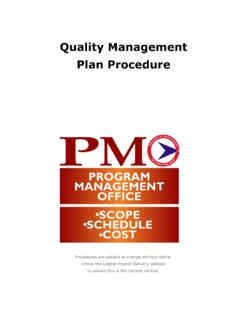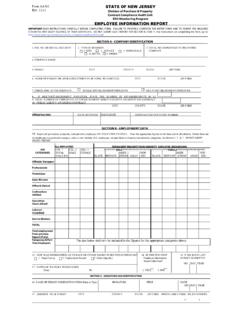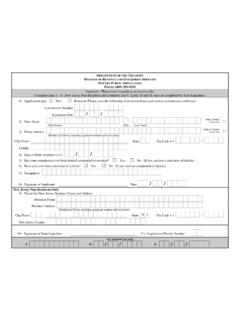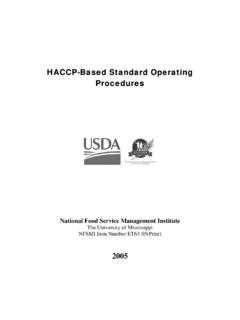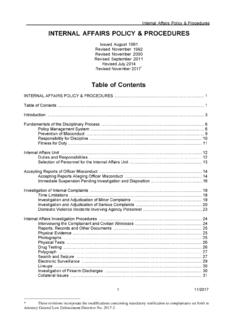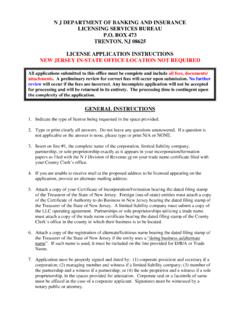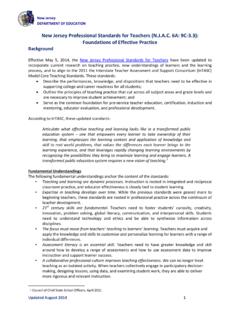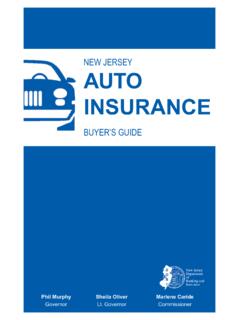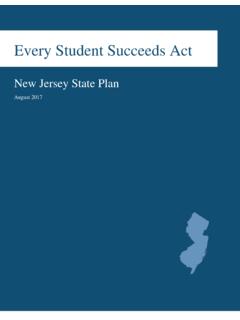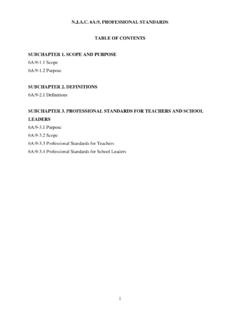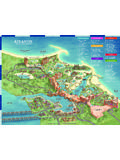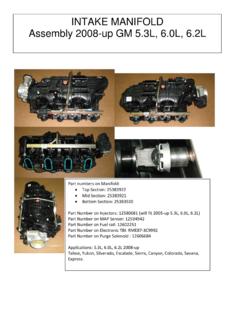Transcription of CHAPTER 23. UNIFORM SUBCHAPTER 6. REHABILITATION SUBCODE
1 5 This file includes all Regulations adopted and published through the New jersey Register, Vol. 50 No. XX, November 19, 2018 New jersey Administrative Code > TITLE 5. COMMUNITY AFFAIRS > CHAPTER 23. UNIFORM CONSTRUCTION CODE > SUBCHAPTER 6. REHABILITATION SUBCODE 5 Introduction; using this SUBCODE (a)This section is a guide to the use of the REHABILITATION SUBCODE . It should not be interpreted as containingsubstantive requirements and it is not intended to be cited for enforcement provisions of the other subcodes of the UNIFORM Construction Code do not apply to work inexisting buildings, changing the use of an existing building or work in an existing building related to anaddition unless the provisions of this SUBCODE specifically reference them and make them , the New jersey UNIFORM Construction Code has made the requirements that areapplicable to new buildings also apply to buildings whose use is changed; applicable to buildingsundergoing REHABILITATION with the extent of the requirements depending on the amount of money beingspent on the building; and to some extent applicable to existing buildings that have an additionconstructed.
2 Buildings whose use was changed and buildings receiving REHABILITATION costing more than50 percent of the replacement cost of the building were required to comply with all the provisions of theUniform Construction Code for new SUBCODE takes a new approach. The requirements that apply to a project are based upon thetype of work being done rather than on the extent of the work. There is only one exception to this the case of reconstruction work, as the term reconstruction is defined in this SUBCODE , there aresome requirements which must be met when the project is a large one in floor this SUBCODE , work is classified into six categories. Each category has a separate section whichdescribes the requirements for that category of work. The categories are repair, renovation, alteration,reconstruction, change of use and additions. These terms are defined in 5 Thedefinitions are critical to understand the distinctions between these six categories of work.
3 Where aproject contains more than one category of work, each applicable category must be consulted for therequirements for that category of work.(b)Repair Work: The requirements that apply to repair work are in 5 The requirements forrepairs are brief due to the limited nature of the work. There is a short list of materials that may not be used forrepair work due to their inherently hazardous nature and another list of materials that must be used inconnection with repair work where applicable. These lists should be used when planning the repair componentsof any SUBCODE does not establish when a permit is required for a project. Those requirements are 5:23-2. Although it is generally true that repair work undertaken by itself does not require aconstruction permit, it is important to understand that any repair work undertaken in connection with aproject that involves other categories of work is required to meet only the provisions for the repaircategory established by this SUBCODE .
4 There is no limit to the amount of repair work which may beundertaken. The decision to renovate rather than repair is made only by the installation of smoke alarms is required in any building of Groups R-3, R-4, R-5, and in dwellingunits of Group R-2 that undergo a version to be obtained from Lexis Nexis, 2 of 5 installation of carbon monoxide alarms is required in buildings of Groups I-1, R-1, R-2, R-3, R-4, or R-5 containing a fuel burning appliance or having an attached garage.(c)Renovation Work: The requirements that apply to renovation work are in 5 Renovation is defined in 5 are short lists of materials that may not be used and materials or practices which must be used, where applicable, when renovation work is undertaken. These lists should be used when planning a project which involves renovation installation of smoke alarms is required in any building of Groups R-3, R-4, R-5, and in dwelling units of Group R-2, which undergoes a installation of carbon monoxide alarms is required in buildings of Groups I-1, R-1, R-2, R-3, R-4, or R-5 containing a fuel burning appliance or having an attached work must comply with 5 , Materials and methods.
5 All materials used for the renovation work must meet the standards for those materials established by 5 and methods of installation must comply with that section. 5 , Materials and methods, references and makes applicable to renovation work certain specified subsections of the other subcodes of the UNIFORM Construction Code. Only those subsections specifically referenced in 5 apply to renovation work. All materials and methods used in renovation work must comply with the requirements of that SUBCODE never requires renovation. Any existing work may be repaired. The requirements for renovation apply only where the owner decides to renovate.(d)Alteration Work: The requirements that apply to alteration work are in 5 Alteration is defined in 5 5 , Alteration work, contains short lists of materials that may not be used and materials or practices which must be used, where applicable, when alteration work is undertaken.
6 These lists should be used when planning a project which includes alteration installation of smoke alarms is required in any building of Groups R-3, R-4, R-5, and in dwelling units of Group R-2, which undergoes an installation of carbon monoxide alarms is required in buildings of Groups I-1, R-1, R-2, R-3, R-4, or R-5 containing a fuel burning appliance or having an attached work must also comply with materials and methods that are set forth in 5 alteration work, the configuration of the building is changed in some manner. The definition of "alteration" in 5 provides the information needed to fully understand this term. Because improper alteration work could create a safety hazard in the building, this SUBCODE contains specific requirements which define these hazards. These are the basic requirements of the SUBCODE which can be found in 5 through SUBCODE includes basic requirements, listed by group, with the exception of egress capacity, interior finish requirements, commercial cooking operations, and windowless stories which apply to all groups.
7 Reference should be made to the list of basic requirements applicable to the particular group in which the building being altered falls. Care should be taken to ensure that the alteration will not create a non-conformity with any of the basic requirements which did not exist before the alteration was alterations create what are defined to be new building elements. There is a specific listing of those items which are to be treated as newly-created building elements which can be found in 5 The elements on that list are required to conform to certain specific sections of the other subcodes of the UNIFORM Construction Code. The sections with which each newly-constructed element must comply are listed in 5 Any alteration which creates one of the elements listed in that section must comply with the specific requirements listed in 5 version to be obtained from Lexis Nexis, 3 of 5 to the accessibility of buildings may be required when alteration work is undertaken.
8 Those requirements are specified in 5 (e) and (k).(e)Reconstruction Work: The requirements that apply to reconstruction work are in 5 Reconstruction is defined in 5 Unlike repair, renovation, and alteration, reconstruction is not a kind of work. A reconstruction may, as the definition of the term makes clear, include a combination of repair, renovation, and alteration work. It is the extent and nature of the work which makes a project a reconstruction. There are no quantitative criteria which determine whether a project is a reconstruction. A project becomes a reconstruction when the area where the project is taking place cannot be occupied while the work is in progress and when a new certificate of occupancy is required before the area can be re-occupied. Both criteria must be SUBCODE requires that a reconstruction project have a delineated work area.
9 This area is established by the permit applicant. The term "work area" is defined in 5 A reconstruction project must always involve an entire use, primary function space, or tenancy as those three terms are defined in 5 Projects which do not involve an entire use, primary function space, or tenancy are not reconstruction a reconstruction project is comprised of repair, renovation and alteration work, all of the requirements that apply are found in 5 For ease of use, this section has been written to include all of the requirements applicable to reconstruction. The entire work area must conform to the basic requirements in 5 through These sections must be carefully reviewed when a reconstruction project is being basic requirements are organized by individual groups in 5 through Only the sections relevant to the building's group must be consulted.
10 Where a project involves mixed uses, then the special provisions of 5 should also be consulted. Basic requirements that apply to all groups are in 5 and Therefore, 5 , , and the specific group section between and must be consulted for the basic requirements which apply to a addition to meeting the basic requirements, certain reconstruction projects must meet the supplemental requirements found in 5 through There is a specific section for each group as is the case with the basic requirements. Supplemental requirements that apply to all groups are in 5 and The supplemental requirements apply only when the work area for a reconstruction project exceeds a certain size. Each supplemental requirement has its own threshold of owner of a building in which a reconstruction project is planned must review the supplemental requirements applicable to the use of the project to determine if any of those requirements applies to the project.
